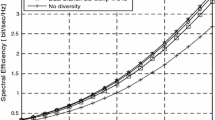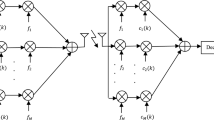Abstract
In this paper we investigate throughputs of Slotted-ALOHA code division multiple access systems with differential detection upon L-branch antenna by means of maximum ratio combining (MRC) diversity technique. We investigate the effects of co-channel interference by employing two different fading models (i.e. between the desired signals and its interferences.) We consider systems under Nakagami/Nakagami and Rician/Nakagami fading environments. The purpose of employing MRC diversity and differential phase shift keying with L-branch antenna is to overcome multipath fading interference in order to enhance the performance of the systems. Our research indicates that the implementation of L-branch antenna in the receiver have reasonably increased the throughputs of the systems. Furthermore, we also investigate the inverse relation between interference signal and the throughputs of the systems. We further point out that the value of Nakagami fading parameter M and Rician factor K are proportional to the achievable throughputs of the systems.






Similar content being viewed by others
References
M. S. Do, Y. J. Park, J. Y. Lee, The effect of spreading gain control on a CDMA slotted ALOHA system, IEEE Transactions on Computers Communication, Vol. 26, pp 996–1006.
A. Sheikh, Y.-D. Yao and X. WU, The ALOHA system in shadowed mobile radio channel with slow or fast fading, IEEE Transactions on Vehicular Technology, Vol. 39, No. 4, pp. 286–289, 1990.
J. A. Roberts and T. J. Healy, Packet radio performance over slow rayleigh fading channel, IEEE Transaction on Vehicular Technology, Vol. COM-28, No. 2, pp. 279–286, 1980.
J. C. Anbark and W. Van Blitterswijk, Capacity of slotted ALOHA in rayleigh fading channel, IEEE Journal on Selected Areas in Communication, Vol. SAC-5, No. 2, pp. 261–265, 1987.
A. S. Al-Semari and M. Guizani, Channel throughput of slotted ALOHA in Nakagami fading environment, IEEE Transaction on Communications, 1997.
M. Abdel Hafez and F. Alagoz, A generalized performance study of DS-CDMA uplink/downlink receivers in Nakagami wideband fading channel, IEICE Transactions on Communications, Vol. E88-B, No.1, pp. 333–344, January 2005.
K. W. Sowerby and A. G. Williamson, Outage probability calculations for a mobile radio system having multiple rayleigh interferes, Electronics Letters, Vol. 23, pp. 600–601, 1987.
Y. D. Yao and A. U. H. Sheik, Outage probability analysis for micro-cell mobile radio systems with co-channel interferers in Rician/rayleigh fading environment, Electronics Letters, Vol. 26, pp. 864–866, 1990.
Y. D. Yao and A. U. H. Sheik, Investigations into co-channel interference in microcellular mobile radio systems, IEEE Transactions on Vehicular Technology, Vol. 41, No. 2, pp. 114–123, 1992.
D. Wijaya and G. Wibisono, BER analysis of CDMA using dual model path gain model, In: Proceeding the 6th seminar on intelligent technology and its applications (SITIA 2005), Institute Teknologi Sepuluh November, Surabaya, 2 May 2005.
G. Wibisono and A. Prakoso, Performance analysis of CDMA using MRC on dual fading model, In: Proceeding EECCIS 2006, Brawijaya University Malang, Part 1, C-135, May 16, 2006.
H. Saragih and F. Santoso, Throughput analysis of adaptive slotted-ALOHA CDMA over a multipath fading channel with capture effects, IJWIN, Vol. 16, No. 4, pp. 217–224, 2009.
H. Saragih, F. Santoso, Capture delay analysis on the throughputs of direct-sequence code division multiple access (DS-CDMA) with slotted-ALOHA (S-ALOH.A) systems over Nakagami/Nakagami fading channels IJWIN 18(3): 186–192 (2011).
C. Chayawan and V. A. Aalo, Average symbol error rate of maximal ratio combining scheme in the multiple co-channel interferers, ECTI Transactions on Electrical Engineering, Electronics and Communications, Vol. 1, No. 1, pp. 38–46, 2003.
H. C. Yang and M. S. Alouini, Closed-form Formulas for The Outage Probability of Wireless Communication System with a Minimum Signal Power Constraint, University of MinnesotaMinneapolis, 2002.
I. Gradshteyn and I. Ryzhik, Tables of Integrals, Series and Product, AcademicNew York, 1980.
M. Abramowitz and I. A. Stegun, Handbook of Mathematical Functions, Dover, 1970.
Acknowledgments
The author gratefully acknowledges the contribution from the anonymous referees whose efforts greatly improved the presentation of this manuscript.
Author information
Authors and Affiliations
Corresponding author
Rights and permissions
About this article
Cite this article
Saragih, H., Santoso, F. Differential Maximum Ratio Combining (MRC)-Based Throughput Analysis on Dual-Fading Models of Slotted-Aloha CDMA Systems. Int J Wireless Inf Networks 21, 154–160 (2014). https://doi.org/10.1007/s10776-014-0237-9
Received:
Accepted:
Published:
Issue Date:
DOI: https://doi.org/10.1007/s10776-014-0237-9




